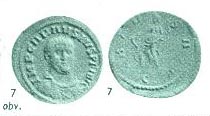

| 1. & 2. Carausius, A.D. 288-93
[?Clausentum=Bitterne],
co-emperors, secular games.
3. Maximian [London] |

| 4. Carausius, A.D. 288-93,Wolf & twins.
5. Allectus, A.D. 293-6, Sun. 6. Magnus Maximus[London] 7. Carausius [Clausentum] |
Carausius produced a short lived independent regime soon after
the empire of Postumus ended. Postumous had visited Britain and Carausius,
as indicated by his coinage, modelled himself on the emperor (7. SALVS,
well-being).
Carausius had his coinage minted at London (M.L.=Moneta Londinensis)
and perhaps at Bitterne (C.=Clausentum?) not far from Portchester.
The coinage indicates a peace he extorted from Rome as they are inscribed
PAX AVGGG -"The peace of the emperors"- the repetition of the final letter
indicating three emperors are mentioned, himself with Diocletian
& Maximian.
The Secular Games were normally held in Rome periodically to purify
the taints of the past and install a new golden Age. The coin (1) indicates
these games may have been held in London.Later Carausius turned pirate
and defeated Maximian at sea., these coins show he at least was granted
outward recognition, he even describes the other two as his brothers when
the heads are labelled CARAVSIVS ET FRATRES SVI -"brothers"- and he also
issued coins in the names of both of them.
Later Britain became the base for usurpers when the governors Magnus
Maximus (A.D. 383-88) and Constantine III (A.D. 407-411) invaded the continent
and sought successfully, in the case of Magnus Maximian, to reach
Rome.
For a time Carausius controlled Northern France, his coin circulation
indicate the limits to his influence in this region.